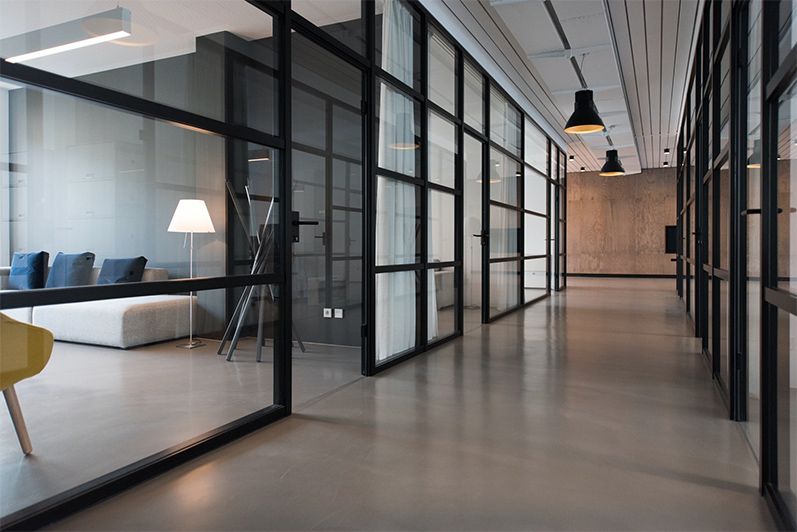Exploring the Differences Between Cleaning, Disinfecting and Sanitizing

With the United States administering more than 2 million COVID-19 vaccine shots per day, many Americans are starting to contemplate their post-pandemic future.
"We've turned a corner," Claire Hannan, executive director of the Association of Immunization Managers told NPR. "We're just getting vaccines out, day in and day out, and we're making progress." Many employees may soon “turn that corner” literally, as well as figuratively, as workers transition from work-from-home back to their office buildings. Some, however, are hesitant about their building’s cleanliness and safety.
In fact, a survey released by Honeywell in January 2021 of 2,000 workers that typically work in buildings with 500 or more employees across the United States, United Kingdom, Germany, and the Middle East found that 68 percent do not “feel completely safe working in their employer’s buildings” and 23 percent “would look for a new job rather than return to a site that did not implement necessary safety measures.”
Employers and building managers can make their returning workers to feel safe is to provide not only daily cleaning, but to make sure the workplace is disinfected and sanitized. While many people assume that cleaning, disinfecting, and sanitizing are the same thing, they are three separate concepts.
Sanitize by Cleaning, Disinfecting or Both
Cleaning, disinfecting, and sanitizing are really three distinct terms that describe methods for removing dirt and germs from your workplace. A surface, for example, could be cleaned but not disinfected; and a surface could be disinfected but not cleaned.
Confused?
Think of it this way: cleaning is the physical act of removing the dirt, dust, and other debris on surfaces, but does not guarantee the killing of germs, bacteria, and viruses.
Disinfecting, however, is the use of disinfectants (chemicals) to kill the germs, bacteria, and virus. Sanitizing is to render a surface safe from germs, bacteria and viruses by either cleaning or disinfecting or both.
Here is a closer look at the difference between cleaning, disinfecting, and sanitizing courtesy of MedlinePlus from the National Library of Medicine:
Cleaning
removes dirt, germs, and dust from objects or surfaces. When you clean, you will likely use soap (or detergent) and water to physically clean the surfaces and objects. This may not necessarily kill the germs. But since you removed some of them, there are fewer germs that could spread infections in the building.Disinfecting
uses chemicals (disinfectants) to kill germs on objects and surfaces. Some common disinfectants are alcohol solutions and bleach. You usually need to leave the disinfectant on the surfaces and objects for a certain period to kill the germs. Disinfecting does not necessarily clean dirty surfaces or physically remove germs.Sanitizing
could be done by either cleaning, disinfecting, or both. Sanitizing means that you are lowering the number of germs to a safe level. What is considered a safe level depends on public health standards or requirements at a workplace, school, etc. For example, there are sanitizing procedures for restaurants and other facilities that prepare food. What you do to sanitize will vary, depending on your needs. You might be mopping a building floor using a mop, a chemical, and water. You may be using a dishwasher to sanitize the dishes. Or you could be using an antibacterial wipe on a TV remote in a conference room.Bottom line is that your office building should be both cleaned and disinfected on a regular basis to ensure that conditions are sanitized. Pay particular attention to high-touch items to prevent the spread of infections.
The EPA and Antimicrobial Pesticides
Disinfectants and sanitizers are two types of antimicrobial pesticides.
The Food and Drug Administration regulates the following for use on people:
- Hand sanitizers
- Antiseptic washes
- Antibacterial soaps
Surface disinfectants are subject to rigorous EPA testing and are held to a higher standard of effectiveness than surface sanitizing products.
The EPA’s List N: Disinfectants for Use Against SARA-CoV-2 (COVID-19) can be found here.
There are no sanitizer-only products on List N as none of them have approved virus claims.
Many products, however, are registered with the EPA as both sanitizers and disinfectants because they have been tested using both standards, and they appear on List N because of their disinfectant ability. The EPA reminds cleaning crews to “follow the directions for virucidal disinfection, and pay close attention to the contact time, which is how long the surface must remain wet. This can often be several minutes.”
Six Steps to Safely Disinfecting
When it comes to disinfecting, the EPA has “Six Steps for Safe & Effective Disinfectant Use”:
- Step 1: Check that your product is EPA-approved.
- Step 2: Read the directions, checking for use, surface type, and precautionary statements.
- Step 3: Pre-clean the surface with soap and water if disinfectant directions require or the surface is dirty.
- Step 4: Follow the contact time. Reminder that the surface should remain wet the entire time to ensure effectiveness.
- Step 5: Wear gloves and wash your hands.
- Step 6: Lock up disinfectants when not in use to keep out of reach of children.
Get an estimate today for how Noble Building Services can keep your offices clean, disinfected, and sanitized.

